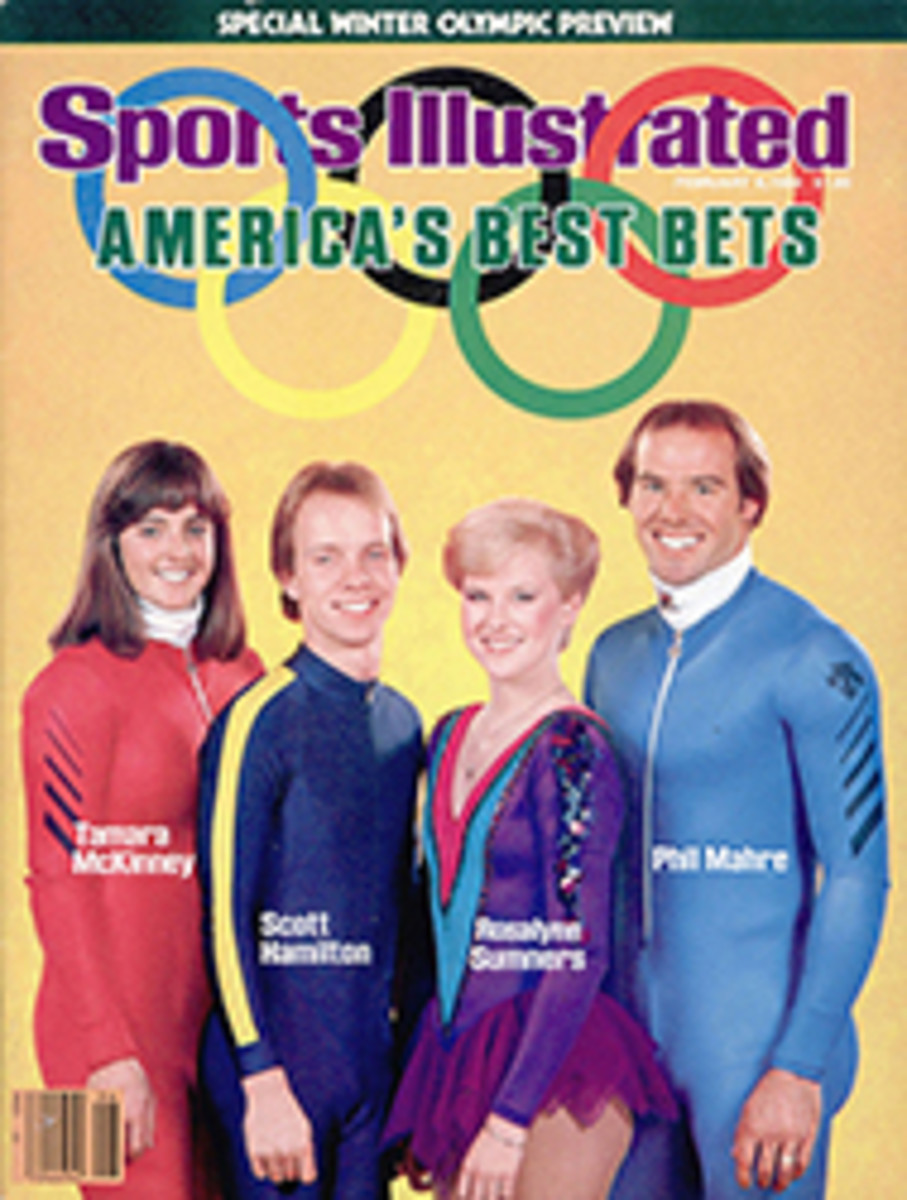
YUGOSLAVIA'S ELAN SKIS, FIRST USED TO DEFEAT NAZIS, ARE WORLD-BEATERS
The company, which was founded in the mid-1940s in the Alps of Slovenia, the extreme northwestern province of Yugoslavia, has its roots in war as surely as Krupp ever did. But it makes skis, not guns. And its war didn't involve grand manipulations of vast armies but rather guerrilla tactics as practiced by valiant bands of Yugoslav partisans against the occupying forces of Nazi Germany.
Among the Slovenian partisans was Rudi Finzgar, a young carpenter and ski jumping prodigy. At age 15, Finzgar had competed for his homeland in Hitler's 1936 Winter Olympics in Garmisch, and he had long been in the habit of making his own skis. The winters of World War II were unusually harsh in the Alps, and it was decided that the partisans would probably be more effective if they were equipped with some first-class skis.
It fell to Finzgar to supervise their manufacture—from cutting down the straightest-grained ash to curing the wood over open-air fires to the final smoothing, planing and curving of the skis. They were heavy and hard to turn, but the partisans used them for everything from swift attacks in snowstorms to nighttime espionage missions against the Nazis. During three years in the mountains, Finzgar and his comrades made about 400 pairs of skis.
When the war ended, Finzgar and nine other former partisans moved down from the Bloke Plateau to the village of Begunje, where they set up shop in a stone farmhouse. And there, on Sept. 24, 1945, they founded the Workers' Ski Cooperative.
What has happened in the ensuing 38 years is impressive indeed. Elan, the name the cooperative adopted in 1952, to project a spirited, international image, is the official ski of the 1984 Winter Olympics in Sarajevo. On the surface, that might seem a predictable bit of favoritism to a poor little native outfit, but Elan is neither poor nor little. It's one of the world's top five Alpine ski manufacturers. No. 1 is Rossignol, with an annual output of 1.8 million pairs. The next four spots are shared by Elan, Fischer, Blizzard and Atomic, all producing 500,000-700,000 pairs annually.
Those first clumsy ash slats cut from the forest by Finzgar have evolved into skis so sleek and so swift that they've been worn by the winners of 81 World Cup races, 17 World Cups in slalom, giant slalom and overall categories, three world championships and two Olympic gold medals. To keep all this success in perspective, it must be added that in all but six of those victories, the Elan skis were on the feet of the same man—Inge-mar Stenmark, the best slalom skier ever.
Whereas the Ski Cooperative had only 10 employees at the start, Elan now has 1,100, and they manufacture more than skis: fiber glass boats and auto parts, weightlifting and gymnastics equipment, and competition sailplanes. The co-op generated an estimated $45 million in revenues in 1983; a bit more than half that total was from skis, of which some 80% were exported.
Elan's world headquarters is still in Begunje. Finzgar was named managing director of the organization in 1945, and he served in that capacity until 1958, when he retired at the age of 38. Back then Tito's grateful government arranged for extra-early and extra-lucrative retirement for men who had fought with the partisans during World War II. Now 63, Finzgar still lives within a couple of miles of the Elan compound.
The man currently heading up the co-op is Dolfe Vojsk, 52, a dynamic fellow with bright blue eyes who began working as a mechanic at Elan in 1951. He was elected—yes, elected is the word—managing director nine years ago. Under Yugoslav socialism, workers' councils representing different divisions of a "company" vote yes or no on all major decisions.
Perhaps the most important talent a manager of a Yugoslav enterprise can have is the ability to sell his workers' councils on new ideas. Through a translator, Vojsk, who makes only about $10,000 a year—the average cooperative worker earns around $4,000—recently spoke with humor and candor about such campaigns. "Sometimes they ask hard questions, like a journalist's questions," he said. "Sometimes they ask questions like a slow child's questions. Naturally, all members of a workers' council aren't qualified to create new ideas. We know that, they know that. But when the ideas are proposed to them, they are automatically qualified to approve or disapprove. Managers can only follow their lead."
Vojsk then turned to Vinko Bogataj, 52, longtime head of Elan's ski department, and said one word, "Ingemar." Bogataj smiled and then spoke in English: "Years ago, when Stenmark was not yet an Olympic champion, we wanted to put him under contract. This was very difficult to persuade our workers to agree to. They found it very hard to believe that paying this young skier a goodly amount of money would result in increasing the money we would get through sales of skis. We had to admit it was something of a gamble. They were very skeptical. They finally decided that they would at least try it for a while. If they had voted no, Elan skis would have had a very different career, I think."
True enough. The importance of Stenmark to the success of Elan skis simply can't be exaggerated. Tim Jamieson, president of Elan Monark, the cooperative's U.S. distributor, which will sell about 90,000 pairs of skis this season, says flatly, "Ingemar was absolutely pivotal to Elan's success. Without his technical input and racing results, Elan wouldn't have developed the way it has."
The story of how the world's best slalom racer came to use Yugoslav skis is both simple and sweet. In the mid-1960s a Swedish pump salesman named Lars Bengtsson was dealing in Yugoslavia, and since Yugoslavia would then deal with the West only on a barter basis, he agreed to take Elan skis back to Sweden as payment for his pumps. There wasn't much interest in Alpine skiing in Sweden then, so Bengtsson staged races for promising young skiers, giving Elans to the winners.
At the time, Stenmark was not yet 10 years old, a lonely, serious child who lived with his grandparents near the Arctic circle. The first year Bengtsson made his offer, Stenmark won a race—and a pair of Elans. "After that," Bogataj recalls, "every year we gave away skis, and every year there was Ingemar, always Ingemar."
Around 1970, Elan decided to try to become a supplier to national ski racing teams. "However, none of the big skiing countries wanted Elans," says Bogataj. "But, then, none of the big-name Alpine ski manufacturers wanted Scandinavia, because almost all the skiing there was Nordic. So we went to the Swedish federation, and we found they were happy to have Elan skis. At the 1972 Olympics in Sapporo, all Swedes were on Elan racing skis."
Stenmark, at 15, was on that Olympic team. Shortly afterward, other brands of skis were allowed to supply the Swedish team, but Stenmark stayed with Elan. He, along with his father, Erik, and his coach, Hermann Nogler of Switzerland, was able to give Elan's highly competent engineers a technical analysis of their racing skis.
"As a result," says Jamieson, "Elan came up with a radical change in racing skis. The modification had to do with a technical change in the sidecut. Slalom skis before had been boardy and inflexible, but this new design that Stenmark and the engineers created made the skis more flexible and helped them to turn better."
Stenmark is a millionaire a few times over now. It has been estimated that Elan has paid him an average of $250,000 a year for the past four years. But despite Stenmark's remarkable success on Elans, the only other outstanding slalom racers to use them have been members of the Yugoslav team. Vane Branik, Elan's promotion director, gives this explanation: "Top racers don't want our skis, they want money. We cannot afford what they ask."
Alas, at the Sarajevo Olympics the official ski will be going into battle without its star. Stenmark, who now resides in Monaco, won't race. He told his friends in Begunje many months ago that he couldn't enter the Olympics because he would have to pay something like 87% taxes to Sweden on all his earnings since 1980 if he wanted to represent Sweden in Sarajevo. Bojan Krizaj, a Yugoslav star, skis on Elans, and he could well get a medal or two. Still, were he to win a gold, which isn't inconceivable, it would only be Elan's second-greatest victory in the mountains of Yugoslavia.
PHOTO
JERRY COOKE
Stenmark has shown true élan on the World Cup circuit.

